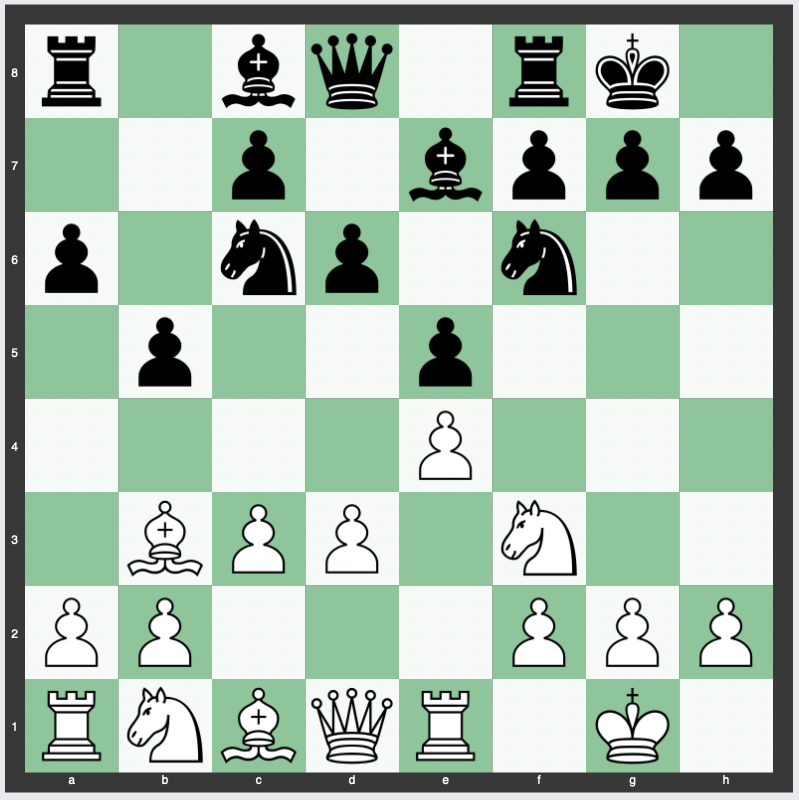The Pilnik Variation is a fascinating and complex line within the Ruy Lopez, one of the most well-known and respected chess openings.
It is named after the Argentine Grandmaster Herman Pilnik and has been employed by many top players throughout history.
This article will delve into the intricacies of the Pilnik Variation, exploring its move order, theory, strategy, variations, history, suitability for different levels of players, and its prevalence at the Grandmaster level.
Move Order of the Pilnik Variation
The Pilnik Variation follows the sequence 1. e4 e5 2. Nf3 Nc6 3. Bb5 a6 4. Ba4 Nf6 5. O-O Be7 6. Re1 b5 7. Bb3 d6 8. c3 O-O 9. d3.

This sequence of moves is characterized by a slow buildup and a focus on solid development.
Theory, Strategy, and Purpose of the Pilnik Variation
The Pilnik Variation emphasizes a solid and flexible pawn structure.
It aims to control the center and create opportunities for both tactical and strategic play.
The moves are carefully chosen to maintain balance and create a complex middlegame.
Sub-Variations of the Pilnik Variation
Within the Pilnik Variation, there are several sub-variations that can lead to different types of positions.
These include different responses to the central pawn structure and various knight or bishop maneuvers.
Understanding these sub-variations can provide players with more options and deeper insights into the game.
9…Na5, 9…Re8, 9…h6, 9…a5, 9…Qd7, 9…Bd7, 9…Be6, and 9…Bb7 are options for black.
9…Na5 is considered the strongest move and leads to a nearly even game for black.
Sample continuation lines include:
9… Na5 10. Bc2 c5 11. h3 Re8 12. Nbd2 Nc6 13. a4 Bd7 14. Nf1 h6 15. Ng3 Bf8 16. d4 cxd4 17. cxd4 Nxd4 18. Nxd4 exd4 19. axb5 Bxb5 20. Nf5 d5 21. e5 d3 22. Bxd3 Bxd3 23. Qxd3 Ne4
9… Na5 10. Bc2 c5 11. Nbd2 Nc6 12. h3 Re8 13. a4 Bd7 14. Nf1 h6 15. Ng3 Bf8 16. d4 cxd4 17. cxd4 Nxd4 18. Nxd4 exd4 19. axb5 Bxb5 20. Qxd4 Qc7 21. Bb1 d5 22. e5 Bc5 23. Qc3 d4 24. Qf3 d3 25. Bd2
9… Na5 10. Bc2 c5 11. Nbd2 Nc6 12. h3 Re8 13. a4 Bd7 14. Nf1 h6 15. Ng3 Bf8 16. d4 cxd4 17. cxd4 exd4 18. axb5 axb5 19. Rxa8 Qxa8 20. Nxd4 b4
9… Na5 10. Bc2 c5 11. h3 Re8 12. Nbd2 Nc6 13. a4 Bd7 14. Nf1 h6 15. Ng3 Be6 16. d4 cxd4 17. cxd4 exd4 18. Bf4 Rc8 19. axb5 axb5 20. Ne2 Nb4 21. Bb1 d3 22. Ned4 Qb6 23. Be3 Bd7 24. Bxd3 Nxd3 25. Qxd3
History of the Pilnik Variation
The Pilnik Variation is named after Herman Pilnik, an Argentine Grandmaster who was active in the mid-20th century.
It has been played by many top players and has contributed to the rich history of the Ruy Lopez.
Is the Pilnik Variation Good for Beginners or Intermediates?
The Pilnik Variation can be suitable for both beginners and intermediate players.
For beginners, it offers a solid foundation and clear principles of development.
For intermediate players, it provides opportunities to explore complex strategic themes.
How Often Is the Pilnik Variation Played at the Grandmaster Level?
The Pilnik Variation is not as commonly played at the Grandmaster level as some other lines in the Ruy Lopez.
Much of this has to do with the fact that 9.h3 is considered a stronger move than the 9.d3 that leads to the Pilnik Variation.
9.h3 leads to the Chigorin, Breyer, Karpov, Smyslov, Zaltsev, Kholmov, Keres, and other popular Closed Ruy Lopez systems, so 9.d3 is more of a sideline that is still solid but leads down a less-trodden theoretical path.
However, it has been employed by some top players and can be a valuable weapon in a player’s repertoire.
ECO C90 Ruy Lopez, Closed, Pilnik Variation (White perspective)
Conclusion
The Pilnik Variation of the Ruy Lopez is a rich and multifaceted opening that offers a wide range of strategic and tactical possibilities.
Its solid structure and complex nature make it suitable for players of various skill levels.
While not as prevalent at the Grandmaster level, it remains an interesting and valuable part of chess opening theory.
Understanding the Pilnik Variation can enhance a player’s understanding of chess and provide them with a versatile tool in their competitive arsenal.


